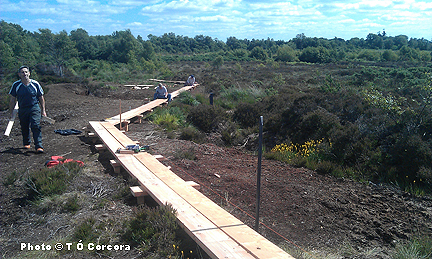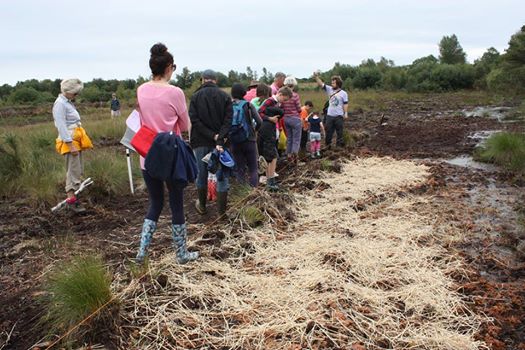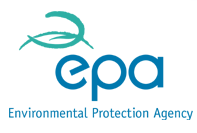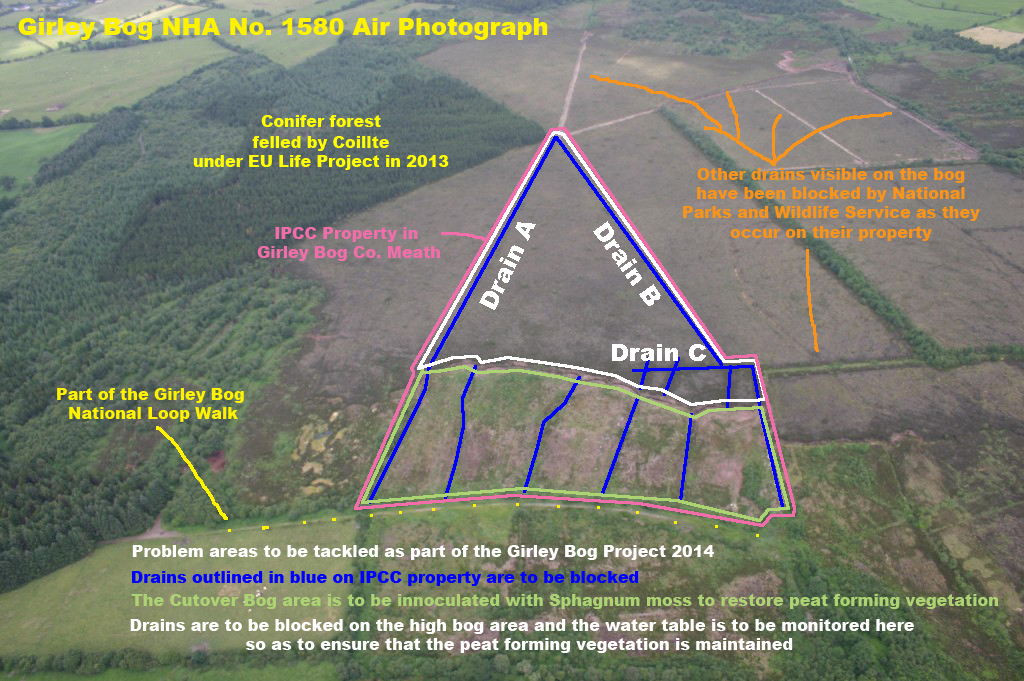





The Girley Bog Restoration Project was a key area of work for the Irish Peatland Conservation Council in 2014 and 2015. The project is a great example of success through community-led conservation.
Brief Background
IPCC purchased 8.5ha of Girley Bog in 2014. Girley Bog is an example of a raised bog and occurs in the eastern part of Ireland in Co. Meath. Human impact on Girley Bog has been intense. The site has been drained, turf has been cut and removed, trees are colonising the surface, a forest was planted on its dome and the bog has been regularly burned. Despite all of these impacts, Girley bog still retains an impressive range of bog building Sphagnum moss plants and ecohydrologists have shown that there still exists active raised bog habitat in the centre of the bog which has the potential to spread provided drains are blocked and trees invading the surface are removed.
IPCC Fundraising and Restoration Actions
The IPCC were fundraising during 2014 and 2015 to help meet the costs of the Girley Bog Restoration Project.
The map below shows the work undertaken with the help of volunteers during this two year project. The work involved the following tasks which were located on the high bog and on the cutover bog:
- Profiling drains and blocking them with drain piling
- Removing invasive pine trees from the bog surface
- Monitor water levels on the high bog before and after drain blocking
- Revegetate part of the cutover bog with Sphagnum moss
- Upgrade the national loop walk along the eastern boundary of IPCC’s property with a new boardwalk
Drain Blocking Plans and Progress
Thanks to the work undertaken by volunteers guided by IPCC’s Conservation Officer at the time, Tadhg Ó Corcora, we estimated that we needed to construct 40 dams across three major drains on the high bog surface (which we have called A, B and C). Our objective was to raise the water table in the central core area of Girley Bog that is rich in peat forming vegetation and Sphagnum mosses to within 10cm of the bog surface. This will sustain the mosses with water so that they can continue to form peat as they grow and die. Further out from the central areas the slopes on the bog increase dramatically due to the effects of marginal drainage associated with turf cutting, and in these areas we blocked drains so that we may replenish the volume of water stored in Girley Bog’s peat. Near the edge of the bog we will used sandwich dams to block drains so as to prevent rainwater from running off the high bog into the cutover. Below is a graphic to show the profile of Drain B which lies on the eastern margin of IPCC’s property. As you can see the difference in height on the bog from the centre to the turf bank is nearly 5.5m over a horizontal distance of just 460m.
IPCC are delighted to report that Drains A and B are blocked and holding water on the bog. We used plastic drain piling sheets which we bought from Masterpile in the UK to construct the majority of the dams in these two drains. Drain C is a complex of 8 small drains at the edge of the bog. All of these were also blocked with sandwich dams constructed from two parallel plastic dams with a layer of peat in between.
Sphagnum Moss Restoration

Volunteers innoculate an area of bare, flat, wet peat with Sphagnum moss plants collected from a donor site. The moss plants are then covered with straw to help retain moisture which helps the plants get established.
IPCC are delighted to report that we have begun to re-establish the growth of the peat forming moss – Sphagnum on the cutover part of Girley Bog. Led by Tadhg Ó Corcora, five volunteers inoculated an area of suitable bare peat adjacent to a flooded drain on a former turf spreading ground on the 14th August 2014. IPCC followed the Sphagnum transfer method of restoration designed by the Peatland Ecology Restoration Group in Quebec, Canada. The water table was raised through backfilling the drains in this part of the bog late in 2013. A high water table (within 10cm of the bog surface) and a very flat surface is needed to create conditions for Sphagnum growth. It takes three years for the mosses to begin to grow on bare peat using these methods.
Volunteers
IPCC have had a great response to our call for volunteers to help us with the work on Girley Bog. We organised several work days. We collected information about the length and slope of the drains on the bog, we measured water levels on the bog and the first dam has been inserted into one of the drains.
During Biodiversity Week in May the MSc Students from Trinity College Dublin visited Girley to learn about its biodiversity and about the restoration techniques being undertaken there. During their visit they helped to remove invasive pine scrub from the surface of the bog.
Education and Awareness
A big part of the Girley Bog Restoration Project is action for education and awareness. The actions carried out in 2014 are as follows:
- Published a visitor map and guide to Girley Bog (download the Girley Bog Visitor Map and Guide published in 2014)
- Constructed a boardwalk along the perimeter of IPCC’s property to upgrade the national Loop Walk around the site. The photograph opposite taken in July shows the boardwalk under construction on the site.
- Trained educators from the Causey Farm Experience to lead ecology trips to Girley Bog: IPCC delivered a work shop to Deirdre Murtagh and her team of guides in 2014.
Open Days
Two family and visitor open days at Girley Bog were hosted by the IPCC in 2014. In addition, on International Bog Day there was a special event led by Kate Flood from Meath Ecotours.
- Biodiversity Day on Girley Bog took place on Sunday 25th May from 2-5pm. A small group turned out (seen above photograph). They did the loop walk, saw a Buzzard, and had tea and treats on the bog. The IPCC’s Volcano Kettle created a great atmosphere.
- On International Bog Day there will be a special event entitled: Girley Bog Walk, Scavenger Hunt & Elderflower Cordial Tasting led by Kate Flood from 10am-12 noon, Sunday 27th July. Meet @ Girley Bog Loop Walk Trailhead Car Park 8km south west of Kells off the N52 in Co. Meath. Further details from Kate Flood, Meath EcoTours www.meathecotours.com
- The IPCC Heritage Week open day at Girley Bog on Sunday 31st August from 2-5pm was well attended. The weather was beautiful and visitors enjoyed a good walk around the site. Of particular interest was the Sphagnum restoration work being undertaken on the cutover bog.
Management Group
There are many people and groups involved in the effort to restore the whole of Girley Bog. IPCC’s work is just a snap shot showing what we must do on the piece of Girley Bog that we own. Other stakeholders are also working hard to improve the long-term chances of survival for Girley Bog. An informal group of stakeholders met regularly during the year to help us to stay abreast of all the great work that is being done to fix the bog and enhance its biodiversity. The meetings also provided a great opportunity for us to work together on developing a management plan for Girley Bog. The stakeholders include Meath County Council, National Parks and Wildlife Service of the Department of Arts, Heritage and the Gaeltacht, Native Woodland Trust, Irish Peatland Conservation Council, Causey Farm Experience, Coillte Teo and Queen’s University Belfast.
Press Information and Stories
- Community-led Conservation of Girley Bog – 13th May 2014
- Practical Bog Conservation Action at Girley Bog – 26th August 2014
Thank You to Our Sponsors
IPCC wish to acknowledge and thank all of our supporters who donated to our fundraising appeals to help purchase Girley Bog and to work on this restoration project.
We also wish to thank the following groups for their support:
 The community-led conservation and awareness programmes on Girley Bog are funded by the Environmental Protection Agency as part of the Science, Technology, Research and Innovation for the Environment (STRIVE) Programme
The community-led conservation and awareness programmes on Girley Bog are funded by the Environmental Protection Agency as part of the Science, Technology, Research and Innovation for the Environment (STRIVE) Programme
The Girley Bog Restoration Project is funded under the Heritage Management Grant Scheme 2014
Meath County Council are supporting the open days on Girley Bog, the publication of the Girley Bog visitor map and guide and the upgrade of the Loop walk around the bog
Further Information
Please email bogs@ipcc.ie if you have any questions at all about this project.







